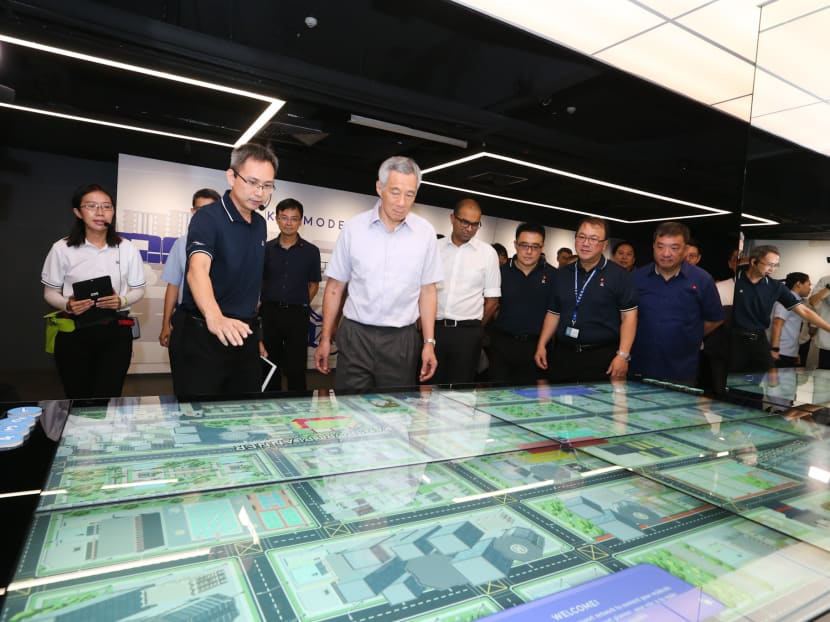Govt seeks views on raising attractiveness of public transport as it shapes next Land Transport Master Plan
SINGAPORE — To keep land transport here in tune with evolving needs, the authorities are canvassing views from the public on shaping the future system, including how to make mass public transport and shared transport services more attractive to users.

The launch of the public consultation document was witnessed by Prime Minister Lee Hsien Loong (front row, second from left), who also unveiled a revamped transport museum at the Land Transport Authority's office on Hampshire Road.
SINGAPORE — To keep land transport here in line with evolving needs, the authorities are canvassing views from the public, including how to make mass public transport and shared transport services more attractive to users.
This is part of an effort launched on Wednesday (Sept 19) to help form the next Land Transport Master Plan, which will chart the future of Singapore’s land transport system until 2040 and beyond.
A public consultation document will outline the key topics for discussion, such as how the “Walk Cycle Ride” vision to make walking, cycling and riding public transport a way of life “can be made more attractive for users”, the Land Transport Authority (LTA) said.
Senior Minister of State for Transport Janil Puthucheary, who leads an advisory panel to consider the public’s feedback, said that the Government’s proposed strategies and the outcomes desired by Singaporeans will require “a significant degree of understanding and compromise”.
For example, if the authorities assign more land to cycling, walking and riding, that will have an “impact on what we can do with roads”.
Developing more infrastructure for autonomous, on-demand or shuttle buses will also have an effect on “what we can do with cars”.
“There are … trade-offs that need to be handled this time round, which are very different from the past, when it was about improving our infrastructure, significantly investing in very physical-heavy goods and assets,” Dr Puthucheary said.
The public’s views will be sought on how the country should strike a balance on the various priorities of the Walk Cycle Ride goal, whether it be comfort, choice or speed.
Walk Cycle Ride covers a range of transport options. They include walking, cycling, mass public transport such as buses and trains, and shared transport services such as taxis and private-hire cars. Some 70 per cent of all peak-hour journeys are made through these modes of transport.
The public may also give its take on ways in which the land transport system can better help those who find it difficult to commute via those modes, or suggest how the Walk Cycle Ride experience can be made easier and more welcoming. Or they may give ideas on how to create a safer land transport system that also enhances "liveability through stronger communities, better health and a cleaner environment".
They should make their views known via an electronic poll (http://bit.ly/LTA_LTMP) or complete a response form (http://bit.ly/LTMP2040PCD) by Dec 31.
They may also sign up to take part in focus-group discussions held by the LTA from next month till January.
Wednesday’s launch of the public consultation document was witnessed by Prime Minister Lee Hsien Loong, who unveiled a revamped transport museum at the LTA office on Hampshire Road near Little India. Mr Lee also attended a ceremony to mark the completion of 200km of sheltered walkways that connect to public transport nodes.
THE GOVT’S PROPOSED STRATEGIES
- Bringing jobs and amenities closer to homes by developing regional centres with mixed uses outside the city-centre. This will cut the distance and time needed for travel, and make walking and cycling more feasible.
- Creating more space for mass public transport and active mobility by developing more "transit priority corridors" with dedicated bus lanes and cycling paths for travel in and across towns, for example.
- More direct travel with fewer or no transfers needed. This will be possible as the rail network continues to expand, and more innovative, technology-enabled transport options are introduced, including on-demand, dynamically routed bus services.
- Inclusive, accessible facilities, such as nursing rooms and diaper-changing stations at key transport nodes.
- Building a more caring, inclusive commuter culture through ground-up efforts to foster positive social norms.
- More space for mass public transport and active mobility which, in turn, encourages more people to walk, cycle and ride public transport, freeing up land for community spaces.
- A safer environment for land transport via education and engineering solutions such as collision detection sensors on buses, and more effective enforcement through the use of closed-circuit television video analytics, for example.
- A cleaner, quieter transport system via tightened emission standards and the use of electric vehicles. Cleaner and greener construction techniques and materials are also being explored for transport infrastructure.
NEXT STEPS
Dr Puthucheary will lead a 15-member advisory panel appointed by the LTA to consider the views amassed through public engagement exercises.
The panel — which includes Senior Parliamentary Secretary (Transport) Baey Yam Keng and Public Transport Council chairman Richard Magnus — will provide its recommendations in early 2019.
These will be infused into the LTA’s vision, policies and targets for the next Land Transport Master Plan.
LTA EXPECTED TO MEET 2030 TARGETS
Public transport to form three-quarters of all peak-hour journeys.
Eight in 10 households to live within a 10-minute walk of a train stop.
85 per cent of public transport journeys under 20km to be completed within an hour.
BACKGROUND
The Land Transport Master Plan is a roadmap for Singapore’s land transport network. The first two master plans were unveiled in 2008 and 2013. The 2013 master plan canvassed views and suggestions from more than 1,700 people — including motorists, public transport commuters and cyclists — and set out targets to improve the transport network by 2030.
Sign up for TODAY's WhatsApp service. Click here:








